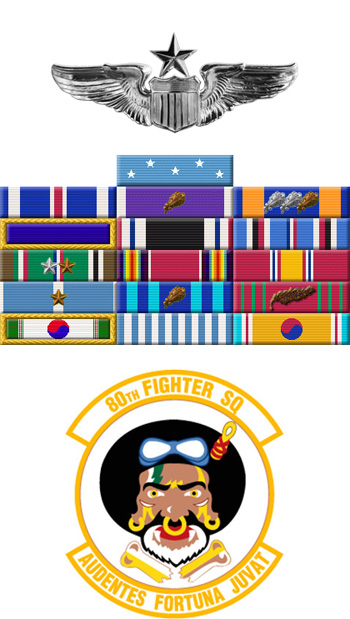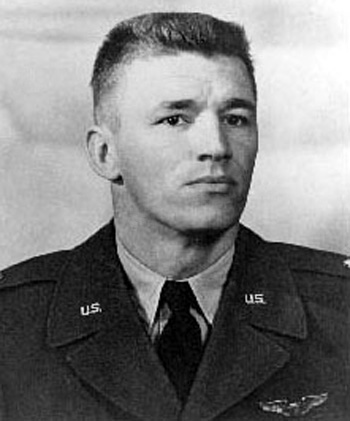Charles Loring was born on October 2, 1918, in Portland, Maine. He enlisted in the Aviation Cadet Program of the U.S. Army Air Forces on March 16, 1942, and was commissioned a 2d Lt and awarded his pilot wings at Maxwell Field, Alabama, on February 16, 1943. His first assignment was as a P-40 Warhawk and then as a P-47 Thunderbolt pilot with the 22nd Fighter Squadron of the 36th Fighter Group in Puerto Rico, South Carolina, and Nebraska, from May 1943 to April 1944, and then deployed to England from April 1944 until he was forced to bail out over occupied Europe and was taken as a Prisoner of War by the Germans on December 24, 1944. Lt Loring was held until his POW camp was liberated on May 5, 1945, and then served as a pilot and post exchange officer at Perrin Field, Texas, from November 1945 to November 1946. His next assignment was as a public information officer at Seattle, Washington, from November 1946 to October 1948, followed by service as an instructor with the Armed Forces Information School at Carlisle Barracks, Pennsylvania, from November 1948 to February 1952. Maj Loring next deployed to Korea where he served as an F-80 Shooting Star pilot with the 36th and then the 80th Fighter-Bomber Squadron of the 8th Fighter-Bomber Group from June 1952 until he was killed in action on November 22, 1952. Loring AFB, near Limestone, Maine, was named in his honor.
His Medal of Honor Citation reads:
Major CHARLES J LORING, JR., distinguished himself by gallantry and intrepidity at the risk of life above and beyond the call of duty as a Pilot with the 8th Fighter Bomber Wing, Fifth Air Force, on 22 November 1952. On that date, Major LORING was leading a flight of four F-80 type aircraft on a close support mission near Sniper Ridge, North Korea. The flight was briefed by a Mosquito controller to dive bomb enemy gun positions along the ridge which were harassing friendly ground troops. After verbally verifying the location of the target by a radio transmission, Major LORING rolled into his dive bomb run. Extremely accurate ground fire was directed on Major LORING's aircraft throughout the long run. However, disregarding the accuracy and intensity of flak concentrated around his aircraft, Major LORING continued to aggressively press his attack, until he was hit by ground fire at approximately four thousand feet. At this point, Major LORING deliberately altered his course and aimed his diving aircraft at active gun emplacements on a ridge northwest of the briefed target. With infinite personal courage and daring, Major LORING elected this sacrifice, turning approximately forty-five degrees to the left and pulling up slightly in a deliberate, controlled maneuver which carried his aircraft directly into the midst of the gun emplacements, destroying them completely. Major LORING's superlative gallantry and valor far beyond the normal call of duty were in keeping with the highest traditions of the military service, and reflected great credit upon himself, the Far East Air Forces, and the United States Air Force.
|



